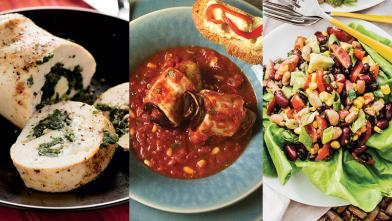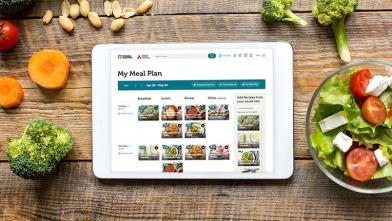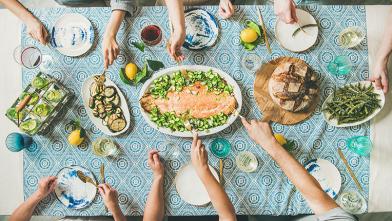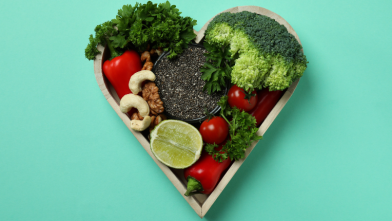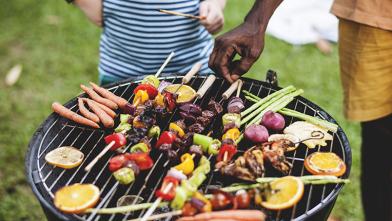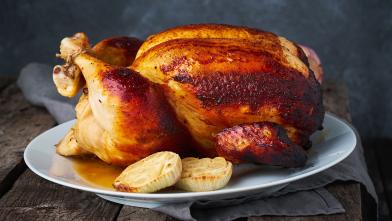Grocery shopping when you have diabetes doesn't have to be complicated or expensive. Simplify meal planning with the Diabetes Plate and try these shopping tips to save on produce and protein foods at the grocery store.
Fresh Produce
Non-starchy vegetables fill half the Diabetes Plate, so always try to have plenty of these on hand. Check sales flyers from your local store and see what fresh produce is on sale, then find recipes that use those vegetables. Remember, in-season fresh produce will be cheaper than those not in season. So try swapping out the fruits or vegetables in a recipe to ones that are in season to save.
Frozen and canned vegetables are also great cost-saving options. Look for frozen vegetables with no added seasonings or sauces—the ingredients should just be the vegetables themselves. For canned vegetables, look for low-sodium or no-salt-added varieties. If you can’t find low-sodium or no-salt-added cans or already have a full salt can at home, rinse the contents with water before adding to your recipe to reduce the sodium level yourself.
Meats and Other Proteins
There are two types of protein foods, meat-based (such as chicken, fish, and beef) and plant-based (such as beans, lentils, peas, and tofu). Meat-based proteins are usually the most expensive part of a meal. But adding more plant-based proteins to your dishes can help lower your grocery bill. A fun way to start incorporating more plant-forward meals is by adding themes to your week, such as meatless Mondays. Every Monday, let plant-based proteins be the star of the show, like in these recipes:
When shopping for meat-based proteins, check both fresh and frozen options to get the best price.
If choosing frozen meat, remember that it needs to thaw before cooking. The safest way to thaw meat is in the refrigerator, which can take 24 hours or more depending on the meat’s thickness. Plan ahead to avoid getting stuck with still-frozen meat when you’re ready to cook.
You may assume that fresh meat is more expensive than frozen, but you can often find great deals or "manager's specials" on fresh meat, poultry, and fish. Buying in bulk can also lower the price per pound, and you can freeze whatever you're not going to use in the next few days.
For frozen and fresh meat, choose products that do not have any added seasoning, breading, or sauces to reduce the sodium, carbohydrate, and fat content for that product. Check the nutrition facts panel and the ingredients as well to see if that food will help support your diabetes management. Ideally, the ingredients will just be the meat itself.
Other Tips
- Check the unit price: The unit price is the cost per ounce or pound (or another unit). You can usually find the unit price on the price tag next to the retail price. This will help you compare prices between different sized packages. Larger packages may be more expensive overall, but the cost per ounce (unit price) might be less because you are buying a larger quantity.
- Buy store brands: Store brands are almost always cheaper than name brand products and the quality is just as good.
- Get creative with your recipes: Most recipes have a lot of flexibility to swap, remove, or add ingredients. You might be able to swap out the meat-based protein in a recipe for a cheaper plant-based one (such as black beans or plant-based ground meat to replace ground red meat) or use different vegetables depending on what's on sale or in season.
- Stick to the basics: Making diabetes-friendly meals doesn't mean you have to buy expensive specialty foods. Low-cost non-starchy vegetables, lean proteins, whole grains, starchy vegetables, fruits, and low-fat dairy can all be included on a diabetes-friendly plate.
- Select lean proteins: Choose lean proteins that are boneless and skinless, like fish fillets and chicken. This will reduce the amount of unhealthy trans and saturated fats and calories you consume, as well as cut down on paying for the elements you will throw away, like skin and bones.
Looking for more mealtime inspiration?
Here are five easy, budget-friendly dinners to add to your meal plan this week. And they can all be made in one sheet pan or pot for easy clean up!
Sheet Pan Salmon & Asparagus Here is a perfect weeknight dinner—it comes together in less than 30 minutes and cooks on one sheet pan for easy clean up. Enjoy this meal in early spring when asparagus is in season!
Sheet Pan Zucchini & Red Pepper "Stir Fry" This recipe looks and tastes like a stir-fry, but it is roasted in the oven instead of cooking it on the stovetop. Just toss everything together, lay it out on a sheet pan, and let it bake! It's great as is, or you could add some additional flavors by sprinkling with peanuts for crunch, drizzle with hot sauce for pow, or add fresh cilantro for herbal flair.
Sheet Pan Roasted Turkey & Vegetables Dinner doesn't get much easier than this! This whole meal comes together in one sheet pan and is ready in less than 30 minutes. It's a perfect low-carb and veggie-heavy weeknight meal!
Baked Whitefish Pouch with Seasonal Veggies The pouches are an easy way to make perfectly cooked and seasoned fish with vegetables. The result—lots of savory sauciness in the pouch after cooking with no clean up!
Budget Friendly Chicken Piccata This budget-friendly classic Italian dish features capers and fresh lemons. Great flavors come together quickly with chicken over a bed of spinach plus whole grain pasta.


